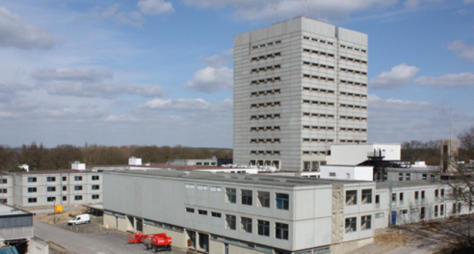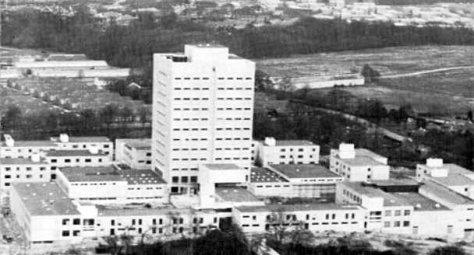© Army Catering Corps Association |
Privacy Policy
|
Cookie Policy
|
Contact Us
|
Benevolence
|
Forces Related Links
A vital supply centre in northern France during WWl has had its name re-used and enshrined in the most famous of all Army towns.
The
practice
of
naming
barracks
in
large
garrisons
after
famous
battles
dates
back
to
the
1890s.
During
the
1920s
and
1930s
when
Aldershot
district
was
being
extended,
a
number
of
First
World
War
actions
were
commemorated
by
naming
new
barracks
in
Aldershot
and
Aborfield
after
them. These included Mons, Lille, Hazebrouck and Poperinghe.
In
1939
a
militia
training
area,
previously
known
as
"The
Sands"
became
the
site
of
St
Omer
Barracks.
This
was
intended
to
be
the
new
Army
School
of
Cookery
then
administered
by
the
Royal
Army
Service
Corps
and
previously
located
at
Mandora
Barracks
Aldershot.
St
Omer
takes
its
name
from
a
French
town
lying
26
miles
south
east
of
Calais,
which
became
the
headquarters
of
the
British
Expeditionary
Force
from
October
1914
until
November 1915.
There
was
no
battle
of
St
Omer
in
the
First
World
War,
but
following
the
battle
of
the
Aisne
(2nd-15th
September
1914)
General
Sir
John
French,
the
Commander
B.E.F.,
withdrew
the
British
Force
to
support
the
Northern
Flank
of
the
allies
and
all
formations
concentrated
around
St
Omer
prior
to
moving east to form the main front line between Ypres-Le Bassee and Armentiers.
St
Omer
continued
to
be
the
Army
HQ
until
the
end
of
1915
and
a
major
communications
and
supply
centre
throughout
World
War
I.
It
was
here
on
14th
November
1914
that
the
great
Field
Marshal,
Lord
Roberts
of
Kandahar
and
Waterford
(who
won
an
early
VC
in
the
Indian
Mutiny)
died
whilst visiting troops in the St Omer area.
The
original
barracks
at
St
Omer,
pictured
above,
were
officially
opened
on
7th
March
1941
two
weeks
before
the
ACC
was
formed.
The
Corps
trained
at
St
Omer
from
1941
until
1993,
when
the
Army
School
of
Catering
and
army
catering
came
under
the
control
of
The
Royal
Logistic
Corps.
Cookery training continued at St Omer until 2006 when all army catering training was moved to the Cookery Training Wing at Worthy Down.
The
1941
barracked
was
demolished
in
the
late
1960s
and
the
new
St
Omer
Barracks
was
officially
opened
by
the
Colonel-in-Chief,
Her
Royal
Highness
the
Duchess
of
Kent
on
the
28th
October
1971.
The
two
picture
below
show
the
barracks
with
the
tower
block
which
contained over 60 kitchen-classrooms, together with lecture rooms, a cinema, a demonstration theatre and two 500 seater dining rooms
Under
the
Allenby/Connaught
Project,
St
Omer
and
the
tower
block
was
demolished
in
2007
and
the
area
was
redeveloped
to
create
modern and flexible living and working environments for soldiers.
St Omer Barracks
The home of the Army Catering Corps



A vital supply centre in northern France during WWl has had its name re-
used and enshrined in the most famous of all Army towns.
The
practice
of
naming
barracks
in
large
garrisons
after
famous
battles
dates
back
to
the
1890s.
During
the
1920s
and
1930s
when
Aldershot
district
was
being
extended,
a
number
of
First
World
War
actions
were
commemorated
by
naming
new
barracks
in
Aldershot
and
Aborfield
after
them.
These
included
Mons,
Lille,
Hazebrouck
and
Poperinghe.
In
1939
a
militia
training
area,
previously
known
as
"The
Sands"
became
the
site
of
St
Omer
Barracks.
This
was
intended
to
be
the
new
Army
School
of
Cookery
then
administered
by
the
Royal
Army
Service
Corps
and
previously
located
at
Mandora
Barracks
Aldershot.
St
Omer
takes
its
name
from
a
French
town
lying
26
miles
south
east
of
Calais,
which
became
the
headquarters
of
the
British
Expeditionary
Force from October 1914 until November 1915.
There
was
no
battle
of
St
Omer
in
the
First
World
War,
but
following
the
battle
of
the
Aisne
(2nd-15th
September
1914)
General
Sir
John
French,
the
Commander
B.E.F.,
withdrew
the
British
Force
to
support
the
Northern
Flank
of
the
allies
and
all
formations
concentrated
around
St
Omer
prior
to
moving
east
to
form
the
main
front
line
between Ypres-Le Bassee and Armentiers.
St
Omer
continued
to
be
the
Army
HQ
until
the
end
of
1915
and
a
major
communications
and
supply
centre
throughout
World
War
I.
It
was
here
on
14th
November
1914
that
the
great
Field
Marshal,
Lord
Roberts
of
Kandahar
and
Waterford
(who
won
an
early
VC
in
the
Indian Mutiny) died whilst visiting troops in the St Omer area.
The
original
barracks
at
St
Omer,
pictured
above,
were
officially
opened
on
7th
March
1941
two
weeks
before
the
ACC
was
formed.
The
Corps
trained
at
St
Omer
from
1941
until
1993,
when
the
Army
School
of
Catering
and
army
catering
came
under
the
control
of
The
Royal
Logistic
Corps.
Cookery
training
continued
at
St
Omer
until
2006
when
all
army
catering
training
was
moved
to
the
Cookery
Training Wing at Worthy Down.
The
1941
barracked
was
demolished
in
the
late
1960s
and
the
new
St
Omer
Barracks
was
officially
opened
by
the
Colonel-in-
Chief,
Her
Royal
Highness
the
Duchess
of
Kent
on
the
28th
October
1971.
The
two
picture
below
show
the
barracks
with
the
tower
block
which
contained
over
60
kitchen-classrooms,
together
with
lecture
rooms,
a
cinema,
a
demonstration
theatre
and two 500 seater dining rooms
Under
the
Allenby/Connaught
Project,
St
Omer
and
the
tower
block
was
demolished
in
2007
and
the
area
was
redeveloped
to
create
modern
and
flexible
living
and
working
environments
for
soldiers.
St Omer Barracks
The home of the Army Catering Corps















